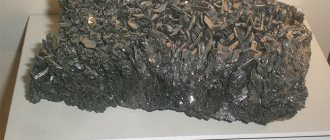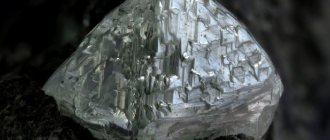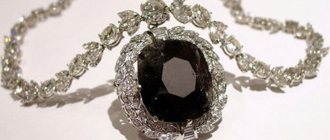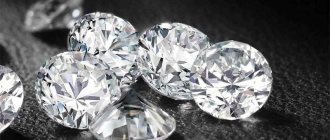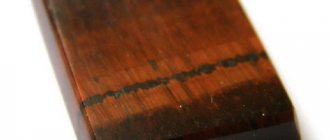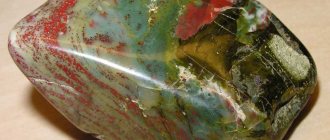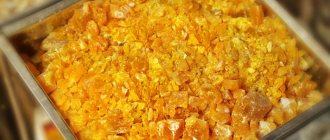What is the difference between a diamond and a diamond, which is more expensive?
To understand the difference between a diamond and a diamond, you should consider the crystals separately:
- Diamond is a stone of natural origin, it consists of carbon and is identical in composition to graphite. However, the bonds of molecules give the mineral an attractive appearance and special properties. Diamond has high strength, thermal conductivity and other positive qualities.
- It can be of various colors, and under the sun's rays it begins to shimmer in all shades. However, in terms of aesthetics, the mineral has no value; it remains dull and similar to an ordinary stone.
- Jewelers process the diamond to give it a magical shine and magnificent appearance. Cut diamonds are called brilliants; they occupy the first place among precious stones and are radically different from pristine minerals.
- Cutting a diamond involves giving it shape and shine. Basically, the number of facets of a diamond is 57 pieces, but the number can be different, depending on the size and color of the stone. Once cut, diamonds acquire high value in jewelry and are used to create luxury items. Well, gems without treatment are used in construction or optical fields.
- The diamond is the most expensive in the world. It even relates to state currency values. The untreated counterpart is of little value, but it should be borne in mind that during processing the weight of the stone decreases significantly.
The differences in price between rough and polished diamonds can be explained by several factors:
- a diamond has aesthetic value, but a rough diamond does not;
- Diamond processing is quite expensive, which significantly increases the final cost;
- not all natural crystals are of high quality and suitable for jewelry;
- The cost of an individual diamond depends on its appearance, clarity, weight, color and treatment.
Difference between stone variations
Diamonds are found in the kimberlite rock and occur as individual crystals, intergrowths of several crystals, or dense aggregates consisting of many small grains. To obtain diamond products after mining, they must be cut to a specific shape.
Diamonds are made from processed diamonds and special (brilliant) cuts. They are available in different sizes, shapes and colors in the market. What sets a diamond apart from other types of gemstones is its ideal angular proportions, allowing it to reflect light brilliantly and sparkle.
So, now it is obvious how a diamond differs from a diamond. To summarize it in one sentence: the first is a natural crystal mineral, and the second is a cut, polished diamond. The process of turning rough stone into exquisite jewelry is a fine art and science.
What is the reason for the widespread use of diamond?
The uniqueness of rough diamonds is undeniable, because the mineral has a uniquely structured crystal lattice. This provides high crystal strength, thermal conductivity and low electrical conductivity.
Helpful information
Diamonds are often used in construction, medical purposes, drilling, television communications, physics, chemistry and optics.
The mineral can be mined in nature in a variety of ways. There are not many diamond deposits in the world; they can only be found in Africa, Russia and Australia. The use of diamond in industry requires a significant scale, but quality in this case does not play a special role, because not the best samples of stones are used for this. For example, diamond discs are useful for grinding.
What are the types of diamond cuts?
Often, a round shape with 57 facets is used for processing; a little less often, a rectangular Emerald cut is used to cut a diamond into a brilliant.
Very often, for a correct and symmetrical round cut, almost half of the stone is removed. But professional jewelers say that this is a worthwhile endeavor, since this is the only way to make a diamond of extraordinary beauty from a natural variant.
However, if the mineral has a square or oblong appearance, then in this case the Emerald cut is often used, since in this case it is not necessary to throw away almost half of the stone.
How does cubic zirconia differ from diamond?
A diamond is a cut diamond, but for some reasons it can be confused with cubic zirconia. You need to know the differences between minerals so as not to purchase fake jewelry at an exorbitant cost:
- Cubic zirconia is a stone of artificial origin. It is produced in special laboratories. Externally, cubic zirconia and diamond are quite similar, but they have different physical and chemical characteristics.
- The main difference between cubic zirconia and diamond is hardness. Stones can equally scratch glass, but if you run the edge of a diamond across the surface of cubic zirconia, clear scratches and marks will remain on it.
- When processing cubic zirconia and diamond, you can see the difference between them in appearance. Jewelry in most cases has 57 facets, they are quite sharp. When cutting cubic zirconia, it does not have so many edges; they look rounded and smoothed. You can immediately identify a stone of natural and artificial origin.
Main characteristics
Diamond is the raw material for producing a polished diamond. Immediately after extraction, such a crystal has no jewelry value. It takes months of painstaking work to turn a plain mineral into a luxurious diamond. Cutting, grinding and polishing change the appearance and size of a diamond, but do not affect its physical properties.
General characteristics that a diamond and a diamond have:
- Hardness. For this property they have no equal among other natural materials. Translated from Greek, diamond means “indestructible.” To verify the strength of the mineral, you can conduct the following experiment: put it in the chamber of a hydraulic press. Gradual directed pressure will not crush the crystal. Nothing will happen to the diamond, but it will cause damage to the press - it will push through the steel base. The exceptional strength of the crystal is explained by its chemical structure - its atoms are packed very tightly.
- Fragility. They can withstand pressure, but are not able to withstand impacts. If you hit a diamond or diamond with a hammer, it will crumble, so it is impossible to make a knife or percussion tool from them.
- Weak conductivity of electric current.
- The highest thermal conductivity among minerals (4 times more than copper).
- Resistance to high and low temperatures. In open air they will burn at 850-1000 °C, in a stream of pure oxygen - at 720-800 °C. If you continue heating, the diamond will eventually turn into carbon dioxide and completely evaporate. As a result, not a trace will remain of the precious stone.
- Not destroyed by time (eternal).
At temperatures above 2000 °C, without access to air, diamond is transformed into graphite, a substance with opposite characteristics. Its hardness is lower than that of paper, and it conducts current very well.
Diamond
Kimberlite or diamond is a valuable mineral, a natural mineral, the progenitor of a diamond. Its structure is pure carbon. Such minerals are formed in the earth naturally - under the influence of high temperatures and pressure. They are found in special deposits. Mining these stones is a complex and time-consuming process, although sometimes they come to the surface.
In appearance, diamonds are nothing special. For those who do not understand minerals, this is an ordinary shapeless rough stone that does not have the characteristic “diamond” shine. It can have any configuration and dimensions. The largest natural black diamond (Sergio) weighs 3167 carats, which is 633.4 g.
Diamonds have a unique quality - high dispersion or play of the stone. When cut correctly, they sparkle and sparkle. One diamond after cutting can produce several diamonds.
Transparent and cloudy diamonds are found in deposits. The color depends on the impurities contained inside. In nature, yellow, pink, brown, green, and black diamonds are found. Blue ones are considered the rarest and most valuable.
Before placing a rough diamond in the hands of a jeweler, it is carefully examined by experts. They evaluate the quality of the stone using a special scale. Then the mineral is subjected to primary processing - peeling. Then it is sent for cutting, as a result of which it turns into a diamond.
The phenomenal properties of the stone were fully appreciated only in the 16th century, although people discovered it earlier (the first mentions of it date back to the third millennium BC). Since then, it has been used not only as a raw material for the production of diamonds, but also for industrial purposes.
Today, 97% of diamonds are grown artificially in chemical laboratories.
Diamond
A diamond is a cut diamond that, as a result of processing, has acquired a shape that reveals its color splendor and regal brilliance. It must have at least 17 edges.
The quality of such a gemstone is assessed according to four parameters (“4C of a diamond”):
- purity;
- carat weight;
- color;
- cut.
There is a popular belief that a natural diamond thrown into a glass of water will become invisible. There is even a legend that in the past, smugglers smuggled such stones across the border by hiding them in a bottle of water. Another myth also appeared: in the old days, jewelers stood at the window and compared its shade with water to determine the transparency of a diamond.
Practical experiments and theoretical calculations refuted the theory that this mineral can disappear in water. It will be visible regardless of cleanliness. The famous expression “pure diamond” comes from jewelers. This is how they speak about a stone that does not reflect in water - it does not contain inclusions.
With the development of laser technology, the concept of a “healed (ennobled) diamond” appeared. This is the name given to a stone from which inclusions have been removed by laser and the free space has been filled with glass material. After such manipulations, the mineral becomes less durable.
Purchasing Tips
When purchasing jewelry with a crystal, you should follow certain recommendations:
- You should look at the gem in a certain light, only then can you see the purity and color of the gem. Jewelry stores should have fluorescent lighting.
- It is advisable to ask for a certificate at a jewelry store; it is required for all diamonds. It is prepared by a special gemological laboratory. The report provides information on the most important characteristics and properties of the gemstone. The document is a crystal passport so that it cannot be confused with other stones.
- When purchasing diamond jewelry, be sure to check its characteristics. Between two seemingly identical stones, the price can vary significantly. This is due to differences in purity and color.
- When purchasing diamond jewelry, you need to look not only at clarity, cut, weight and shade, but also at the treatment. When a gem has excellent shade and transparency, but has strong fluorescence and poor quality proportions, its value is significantly reduced.
- It is necessary to give preference to a gem with weak or zero fluorescence; you should not purchase jewelry with a high degree.
- You need to purchase a stone with a high-quality cut. When it is assessed as inferior, it is advisable not to purchase the product.
Emerald cut
Emerald is a classic stepped shape. Emerald is most often used for stones with a rectangular or square shape. As a rule, the facet of this cut is located parallel to the girdle (the widest place in the stone). The girdle divides the mineral into lower and upper parts. Emerald does not always put the item in an advantageous position in terms of transfusion, but at the same time demonstrates it from its best side.
After processing the stone with the Emerald cut, the stone takes on an octagonal shape with truncated corners. This cut is mainly used when there is a need to express clarity and emphasize the size of the stone. However, Emerald, unlike Kr 57, does not so clearly express the brilliance and shimmer of the stone in daylight.
Evaluation using the 4c system, determining the uniqueness of stones
Jewelry is assessed according to four parameters, according to a certain 4 C system:
- cutting;
- purity color;
- carat weight
The cost of clean stone after processing is determined in accordance with the following factors:
- weight, the greater its mass, the higher the cost, and one large diamond is much more expensive than several small ones;
- purity also plays an important role; stones with defects are worth significantly lower than pure minerals;
- the shade also affects the cost; transparent or saturated colored gems are considered the most expensive, because they are quite rare in nature.
Processing history
Humanity first learned to process minerals several thousand years ago, but turning a diamond into a masterpiece began relatively recently. It is believed that previously they could not change the diamond because it had extraordinary strength. Before that, they were only polished and they were called diamond tips. Nowadays, it is almost impossible to find such jewelry. And it costs much more than processed mineral.
Starting from the second half of the 18th century, jewelers living in Europe learned how to make a platform on stone. After sawing off the top, a flat area was formed. Today, the Emerald shape is made using this principle.
Beginning in the 15th century, turning a diamond into a diamond began to be done by sawing off the lower part. At this moment, a certain plane called Kaletta was formed. After some time, jewelers began to file off the edges and give the stone a rectangular shape, in other words, they made an Emerald. From that moment on, the mineral acquired greater value and began to cost much more.
In the 18th century, a cutting center was located in Amsterdam, where ancient techniques for turning diamonds into diamonds are still used today. The craftsmen from this center were considered the best in all of Europe, and it was there that they began to come up with newer methods of stone processing. Many stones were cut there, including diamonds and even emeralds.
